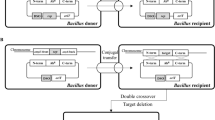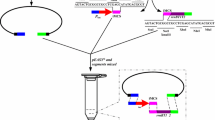Abstract
Plasmid incompatibility, which has no effect on other plasmids or chromosomal genes, can be used to cure a target plasmid. In this report, we successfully cured the plasmid pXO2 from Bacillus anthracis A16 with a newly constructed, incompatible plasmid pKSV7-oriIV and obtained a new pXO2-cured strain, designated A16PI2. This is the first time that a plasmid was cured from the B. anthracis wild-type strain A16 utilizing this principle, which could be considered as an efficacious method to cure large plasmids.






Similar content being viewed by others
References
Anantharaman V, Aravind L (2003) Evolutionary history, structural features and biochemical diversity of the NlpC/P60 superfamily of enzymes. Genome Biol 4:R11
Ariel N, Zvi A, Grosfeld H, Gat O, Inbar Y, Velan B et al (2002) Search for potential vaccine candidate open reading frames in the Bacillus anthracis virulence plasmid pXO1: in silico and in vitro screening. Infect Immun 70:6817–6827
Ariel N, Zvi A, Makarova KS, Chitlaru T, Elhanany E, Velan B et al (2003) Genome-based bioinformatic selection of chromosomal Bacillus anthracis putative vaccine candidates coupled with proteomic identification of surface-associated antigens. Infect Immun 71:4563–4579
Baker TA, Bell SP (1998) Polymerases and the replisome: machines within machines. Cell 92:295–305
Bourgogne A, Drysdale M, Hilsenbeck SG, Peterson SN, Koehler TM (2003) Global effects of virulence gene regulators in a Bacillus anthracis strain with both virulence plasmids. Infect Immun 71:2736–2743
Chitlaru T, Gat O, Gozlan Y, Ariel N, Shafferman A (2006) Differential proteomic analysis of the Bacillus anthracis secretome: distinct plasmid and chromosome CO2-dependent cross talk mechanisms modulate extracellular proteolytic activities. J Bacteriol 188:3551–3571
Finco O, Bonci A, Agnusdei M, Scarselli M, Petracca R, Norais N et al (2005) Identification of new potential vaccine candidates against Chlamydia pneumoniae by multiple screenings. Vaccine 23:1178–1188
Green BD, Battisti L, Koehler TM, Thorne CB, Ivins BE (1985) Demonstration of a capsule plasmid in Bacillus anthracis. Infect Immun 49:291–297
Inglesby TV, O’Toole T, Henderson DA, Bartlett JG, Ascher MS, Eitzen E et al (2002) Anthrax as a biological weapon, 2002: updated recommendations for management. JAMA 287:2236–2252
Kado CI, Liu ST (1981) Rapid procedure for detection and isolation of large and small plasmids. J Bacteriol 145:1365–1373
Marrero R, Welkos SL (1995) The transformation frequency of plasmids into Bacillus anthracis is affected by adenine methylation. Gene 152:75–78
Messer W, Blaesing F, Jakimowicz D, Krause M, Majka J, Nardmann J et al (2001) Bacterial replication initiator DnaA. Rules for DnaA binding and roles of DnaA in origin unwinding and helicase loading. Biochimie 83:5–12
Ni B, Du Z, Guo Z, Zhang Y, Yang R (2008) Curing of four different plasmids in Yersinia pestis using plasmid incompatibility. Lett Appl Microbiol 47:235–240
Park SH, Oh HB, Seong WK, Kim CW, Cho SY, Yoo CK (2007) Differential analysis of Bacillus anthracis after pXO1 plasmid curing and comprehensive data on Bacillus anthracis infection in macrophages and glial cells. Proteomics 7:3743–3758
Shatalin KY, Neyfakh AA (2005) Efficient gene inactivation in Bacillus anthracis. FEMS Microbiol Lett 245:315–319
Smith K, Youngman P (1992) Use of a new integrational vector to investigate compartment-specific expression of the Bacillus subtilis spoIIM gene. Biochimie 74:705–711
Tinsley E, Naqvi A, Bourgogne A, Koehler TM, Khan SA (2004) Isolation of a minireplicon of the virulence plasmid pXO2 of Bacillus anthracis and characterization of the plasmid-encoded RepS replication protein. J Bacteriol 186:2717–2723
Uraji M, Suzuki K, Yoshida K (2002) A novel plasmid curing method using incompatibility of plant pathogenic Ti plasmids in Agrobacterium tumefaciens. Genes Genet Syst 77:1–9
Velappan N, Sblattero D, Chasteen L, Pavlik P, Bradbury AR (2007) Plasmid incompatibility: more compatible than previously thought? Protein Eng Des Sel 20:309–313
Acknowledgments
This work was supported by the State Major Science and Technology Special Projects of China (No. 2008ZX1004-008) and the National Natural Science Foundation of China (No. 30670104).
Author information
Authors and Affiliations
Corresponding authors
Additional information
Huagui Wang and Xiankai Liu contributed equally to this work.
Rights and permissions
About this article
Cite this article
Wang, H., Liu, X., Feng, E. et al. Curing the Plasmid pXO2 from Bacillus anthracis A16 Using Plasmid Incompatibility. Curr Microbiol 62, 703–709 (2011). https://doi.org/10.1007/s00284-010-9767-2
Received:
Accepted:
Published:
Issue Date:
DOI: https://doi.org/10.1007/s00284-010-9767-2




